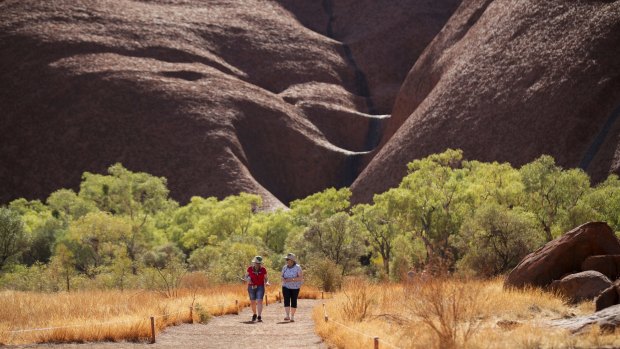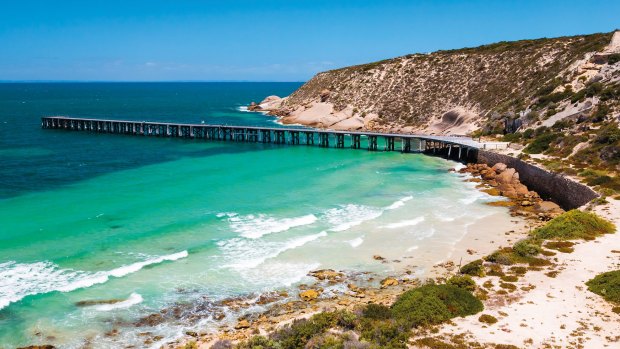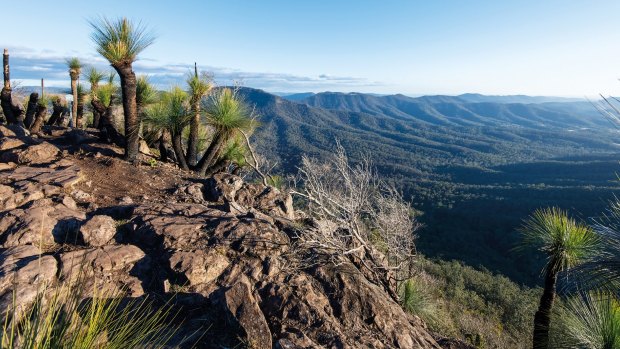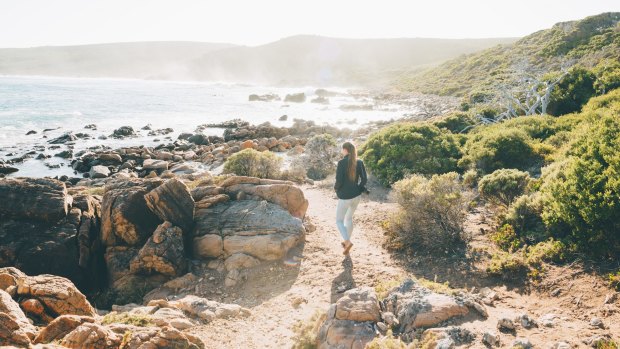This was published 1 year ago
The best hikes in Australia and New Zealand, as named by Lonely Planet

The Tongariro Alpine Crossing is almost universally described as the best one-day walk in New Zealand.
It goes without saying that Australia and New Zealand were both originally explored on foot. But as we set off on our own walking journeys, there are a few matters in these more enlightened days worthy of our consideration.
European explorers traced land routes across the two southern lands and so did the first Indigenous Australians, who, from up to 50,000 years ago, criss-crossed the continent, creating "songlines' or dreaming tracks that told the stories of their people and the landscapes.
In New Zealand, Maori people, such as the Waitaha and Ngati Wairangi, walked deep into the South Island's valleys in search of greenstone or pounamu, which was crafted into tools and weapons. In both nations, walking routes today can help us connect and understand some of that history and add even more meaning to our own explorations.
In Tasmania, for example, the wukalina walk, founded by palawa elder Clyde Mansell, is managed by an Indigenous-owned business that provides visitors with guides who can introduce their culture, entwined as it is with a beautiful stretch of the east coast.
Walkers discover some of the bush tucker of the area and try crafts such as kelp basket-making, while supporting an Indigenous community.
Over on the west coast of New Zealand's South Island, the Greenstone and Caples tracks lead into river valleys along routes used by Maori long before Europeans arrived. What they have in common is that they're doorways to the natural world, where we can connect with nature.
As this extract from Lonely Planet's new book, Epic Hikes of Australia and New Zealand shows, the two countries are walking wonderlands in terms of the variety of terrain, climate and landscape that can be found, not to mention the fascinating cultures, histories and people you encounter along the way.
Here is a selection of Australasian walks that we hope will inspire you to reach for your boots and strike out somewhere new.
OCEAN
THE GREAT OCEAN WALK, VICTORIA

Credit: iStock
THE LOWDOWN The Great Ocean Road may be one of the world's most stunning coastal drives, but the Great Ocean Walk immerses you deep in its coastal wilderness. Make sure you pre-book all your campsites before departing Apollo Bay, following the yellow directional markers. The trail brings you onto the sand of rugged beaches, winds through coastal heath and takes you up hilltops for superb ocean vistas. Highlights include the 1848 Cape Otway Lightstation, camping alongside mobs of eastern grey kangaroos, views of the Southern Ocean from some of Australia's highest cliffs at Gables Lookout, as well as uncrowded vistas of the majestic Twelve Apostles from the designated Great Ocean Walk lookout. From there it's down Gibsons Steps to see the Gog and Magog rock formations before taking the underpass beneath the Great Ocean Road and reaching the finishing line at the Twelve Apostles.
DON'T MISS Take a detour to Wreck Beach to pass the rusty anchors from a couple of old shipwrecks, just two of 180 ships to have met their demise along this treacherous coast.
ESSENTIALS Start, Apollo Bay; finish, the Twelve Apostles. Distance, 104 kilometres; duration: six days average. Go between March-April/September-November. See greatoceanwalk.info
MOUNTAIN
THE JAGUNGAL WILDERNESS, NSW
THE LOWDOWN The peaks and plains of northern Kosciuszko National Park offer wild adventure for hardy bushwalkers, with sweeping views from boulder-clad mountains to rustic huts and abandoned mining relics. In the remote north of the park sits the Jagungal Wilderness, a land of alluring peaks, forested ridges, rolling frost plains and historic gold diggings – and a paradise for walkers seeking solitude in a largely untamed environment. Begin in the boom-to-bust gold town of Kiandra, just north of the Jagungal Wilderness, before heading south on the Australian Alps Walking Track. You'll see panoramas of the high peaks of the Snowy Mountains, traverse the eastern flank of nearby Mount Jagungal and encounter Mawson's Hut (a different Mawson) before reaching Mount Jagungal's sky-piercing 2061-metre summit. Here, pause among the boulders which Aboriginal peoples once sought out in summer to feast on the fat-and protein-rich Bogong moths that migrated there.
DON'T MISS A trail leads downstream beside Valentine Creek to a rock platform between two of the larger cascades of Valentine Falls.
ESSENTIALS Start, Kiandra, finish, Tooma Road-Snakey Plain Trail junction. Distance: 98 kilometres; duration, eight days. Go between November and May. See nationalparks.nsw.gov.au
INDIGENOUS
WUKALINA WALK, TASMANIA
THE LOWDOWN In the far northeast of Tasmania, on the island's flattest corner, there's a hill that passes for a mountain. Rising just 215 metres above sea level, Europeans called it Mount William, though to the palawa (Indigenous Tasmanians) it's always been wukalina. To the Indigenous people, it has been something more than a mountain for hundreds, if not thousands, of years. From this summit, fire was used to signal the Furneaux Islands visible to the north, and today the mountain lends its name to the wukalina Walk, the first tourism venture owned and operated by the palawa community. Launched in 2018, this four-day guided walk is an exploration of country and culture, climbing wukalina/Mount William and hiking the bright and beautiful Bay of Fires coastline. Dotted with middens and sites of ancient Aboriginal shelters, it's a coast that feels custom-made by nature for walking – the town of St Helens at the Bay of Fires' southern end was even known to palawan as kunnara kunna, a name that translates as "easy walking place".
DON'T MISS Larapuna/Eddystone Point is one of the most significant historical sites along this coast, for its effectively a large palawa midden with a lighthouse stacked atop. There are depressions in the land where palawa shelters once stood.
ESSENTIALS Start, Stumpys Bay; finish, larapuna/Eddystone Point. Distance: 33 kilometres; duration, four days. The walk runs from October to April, with trips departing every week or fortnight. See wukalinawalk.com.au
DESERT
ULURU BASE WALK, NORTHERN TERRITORY

Credit: Alex Ellinghausen
THE LOWDOWN Uluru is the world's largest single-rock monolith at 3.6 kilometres long and 348 metres at its highest point with two-thirds of Uluru lying beneath the sand. The Mala car park is one starting point among many for the Uluru Base Walk. Trace Uluru's sandstone carapace undulating like waves cast in stone, caught in the act of crashing upon a desert shore. Elsewhere, vertical lines mark the path of rains that have cascaded down off the high places over millennia past. And small canyons and caves, fissures and pockmarks, tell a story of the relentless winds and sun that have weathered Uluru since it was formed hundreds of millions of years ago. Sections of Uluru's base, including many of its caves, are off-limits to visitors, part of a network of sites that are sacred to the Anangu people. These sites are clearly marked, and, if anything, the prohibitions only reinforce the sense of the privilege of visiting, of the trust placed in visitors by Uluru's Traditional Custodians.
DON'T MISS Close to two-thirds of the way around, a side trail leads past river red gums and through green grasses to Mutitjulu Waterhole, a sacred pool.
ESSENTIALS Start/Finish, Mala car park. Distance: 10.6 kilometres, duration, three to four hours. Go between April-October, the cooler months, though start early to avoid the hottest parts of the day and rug up from the cold. See parksaustralia.gov.au/uluru
COAST
THE YORKE, SOUTH AUSTRALIA

THE LOWDOWN This is a trail that traces the Yorke Peninsula's coastline for a whopping 500 kilometres. A two-hour drive southwest from Adelaide, Walk the Yorke was unveiled in 2016 to showcase the region's magnificent beaches, cliff-top lookouts, wildlife and laid back coastal communities. If you plan on doing the entire 500 kilometres, count on it taking anywhere from 20 to 30 days. Beginning at the top of the "boot" – Port Wakefield is where you'll make your way down past mangroves, beaches and saltpans to reach the "heel" around Edithburgh for clifftops, lighthouses and marine wildlife sanctuaries. It then "arches" past beaches and bays to curl around the "toe" for national parks, dramatic seascapes and long beach walks. Passing Corny Point, you'll reach the top of the "foot" at Point Turton with coastal reserves and rocky headlands, from where it makes its way up the "shin" to finish at Moonta Bay.
DON'T MISS Dhilba Guuranda-Innes National Park, co-managed by the Narungga Traditional Owners, is one of the Yorke's premier attractions, drawing in folk for its beaches, wildlife, shipwrecks and historical ruins.
ESSENTIALS Start/Finish: A manageable walk starts and finishes at Marion Bay (via Gleesons Landing). Distance: 95 kilometres; duration, four days. Go between March and November (unreliable drinking water in summer). See yorke.sa.gov.au
RAINFOREST
THE SCENIC RIM TRAIL, QUEENSLAND

THE LOWDOWN An ancient wilderness protected by 41 national parks and reserves straddling the NSW/Queensland border, the UNESCO World Heritage-listed Gondwana Rainforests of Australia are known for their rich biodiversity, providing habitats for more than 200 rare or threatened plant and animal species. A project of the Turner family, owners of the Spicers Retreats boutique hotel group, the Scenic Rim Trail traces a rainforest-clad ridgeline in Queensland's Main Range National Park on Gondwana's north-western fringe. Linked by three architect-designed eco-lodges, the Spicers' version is a luxurious, guided four-day experience. A five-day option, including a koala walk at Spicers Hidden Vale near the trailhead, is also available. But the Scenic Rim Trail isn't just for walkers with deep pockets. As part of the deal with the Queensland Parks and Wildlife Service, the undulating trail is also publicly accessible, with three basic campgrounds located along the one-way route, hiked from north to south. Requiring you to carry all food and camping equipment, the independent option is a decidedly more adventurous affair. It's also an absolute bargain.
DON'T MISS Scramble up to the Bare Rock lookout (1168 metres), a gorgeous spot to enjoy a packed lunch while soaking up the views across the rolling farmlands below.
ESSENTIALS Start, Thornton View Trailhead, Thornton; finish, Cunninghams Gap, Cunningham Highway.
Distance, 47 kilometres; duration, four days. When to go: April - September, when conditions are cooler and dryer. See parks.des.qld.gov.au
BOTANIC
THE CAPE TO CAPE TRACK, WESTERN AUSTRALIA

THE LOWDOWN A glorious coastal odyssey leading through Western Australia's pristine southwest, The Cape to Cape Track takes in dramatic ocean vistas, wildlife encounters and springtime wildflowers. Take advantage of the free designated hiking campsites, and head out with your tent and portable gas cooker. Perhaps time your run for mid-spring not only for the whale migration, but also for southwest WA's famous wildflowers. Highlights include following the contours of Leeuwin-Naturaliste Ridge and its namesake national park. Skirt the relaxed beach town of Yallingup and onto Smiths Beach with turquoise waters, bone-white sands and ochre lichen-flecked granite formations. Pass Margaret River's famous surf beaches and the seaside hamlet of Gracetown, before continuing among flower-filled landscapes contrasted with dramatic seascapes and spectacular limestone formations, such as the limestone cliffs at Cape Mentelle. There's a beautiful walk amid the towering karri trees of Boranup Forest before returning to a single-track at Boranup Beach and on to your end point: Cape Leeuwin lighthouse.
DON'T MISS Passing Wyadup Bay, the next stop is Injidup Natural Spa, a scenic rock pool that tempts for a quick splash.
ESSENTIALS Start, Cape Naturaliste lighthouse; finish, Cape Leeuwin lighthouse Distance: 125 kilometres. Duration: five to eight days or broken into individual sections. When to go: all year; August-November for wildflowers and whales. See capetocapetrack.com.au
EXTREME
GILLESPIE PASS CIRCUIT, NEW ZEALAND
THE LOWDOWN Ferocious mountains, relentless climbs, river crossings and a celestial-blue glacier lake make this never-to-be-forgotten hike both a beauty and a beast. Mount Awful. Mount Dreadful. Siberia Valley. Crucible Lake. One brief, daunting look at a map of the Gillespie Pass Circuit in New Zealand's Mount Aspiring National Park tells you what you are up against. But this is the secret star of New Zealand's backcountry hikes – a brutal-but-beautiful multi-day trek diving deep into the Southern Alps, where raging rivers, falls, glaciers, whopping great mountains and mossy silver beech forests that are pure Tolkien fantasy stuff await. Website warnings that you should only embark on the hike if you are experienced at crossing rivers aren't kidding. As you set off down on the river valley that sweeps past the trailhead in Makarora, which meanders south to Lake Wanaka, you will catch a glimpse of the jagged, blunt-faced mountains where you'll be heading, many topping the 2000-metre mark. This trek doesn't give up its charms easily: you must tease them out, face the torment of trail and weather and push limits. But it's all the sweeter for it.
DON'T MISS Detour to Crucible Lake from Siberia Hut. It is a wondrous, unforgettable place: dark, glaciated peaks thrusting above a ring of azure water, icebergs chinking softly, waterfalls streaming down sheer rock flanks.
ESSENTIALS Start/Finish: Makarora. Distance: 58 kilometres; duration, three to four days. When to go: Mid-December to late March. See doc.govt.nz
VOLCANO
THE HIKE
TONGARIRO NORTHERN CIRCUIT

THE LOWDOWN The Tongariro Northern Circuit is one of New Zealand's 10 Great Walks and the country's greatest volcanic showcase. Weave among a trio of active volcanoes. The hike includes Mount Ngauruhoe, the most active volcano on the New Zealand mainland and the body-double of Mount Doom in The Lord of the Rings film trilogy. It also includes the Alpine Crossing, almost universally described as the best one-day walk in New Zealand. And then there's the Rangipo Desert, which was once smothered in forest till the world's largest volcanic explosion of the last 5000 years – the 186 CE eruption that created nearby Lake Taupo – obliterated the forest. No tree has ever grown back. As you near the end, not long before Whakapapa Village, find Taranaki Falls, pouring powerfully over a 20-metre-high lava flow. It's a moment of fire and water, desert and flood – the very combinations that make this harsh and startling landscape so compelling.
DON'T MISS Ohinepango Springs, unlike many of New Zealand's thermal springs, it has no heat but it's an impressive volume of gin-clear water.
ESSENTIALS Start/Finish: Mangatepopo Road, Tongariro National Park. Distance, 42 kilometres; duration, three days. Go from mid-October to end-April with December to March the warmest and best time. See doc.govt.nz
This is an edited extract of Lonely Planet's Epic Hikes of Australia and New Zealand (RRP $44.99), see shop.lonelyplanet.com Extract by Julietta Jameson
FIVE MORE GREAT WALKS
LITTLE DESERT DISCOVERY WALK, VICTORIA
This four-day, 84-kilometre walk is through surprising landscapes in the semi-arid Mallee region of western Victoria. Despite the dryness, the Little Desert National Park is anything but barren, with vast areas of native wildflowers, flame heath and woodlands of yellow gum and slender cypress found in its heathlands, salt lakes, rolling dunes, dry woodlands and river red gum forests. The range of birdlife is amazing too. The full 84-kilometre trek is best suited to experienced walkers but there are options for one-to-four-day hikes, and two campsites along the way. See parks.vic.gov.au
CARNARVON GORGE WALK, QUEENSLAND
This deep incision, 400 kilometres inland from Bundaberg, is a work of art from both nature and ancient Indigenous painters. A track threads through the gorge to Big Bend, with several short trails detouring away into side gorges. Prime among them is the simply titled Art Gallery, where a 60-metre long line of cliffs is covered in more than 2000 Aboriginal paintings and ochre stencils – hands, animal tracks, boomerangs. The track is less maintained beyond the Art Gallery, but it's worth continuing to view Cathedral Cave, the second of Carnarvon's art sites. See parks.des.qld.gov.au
GLACIAL LAKES CIRCUIT, NSW
As Australia's highest walking trail, the Main Range Track might well be the classic day-walk of the Snowy Mountains, indeed the Australian Alps. Forming a stunning loop-walk over a range of bulging peaks, ascending Mount Kosciuszko (2228 metres) – Australia's tallest peak– and passing five glacial lakes, this is an immensely popular route in the warmer months. But if conditions are foggy, wet or otherwise inclement, find another destination; this walk is a fine weather outing only. See nationalparks.nsw.gov.au
ROTOMAIREWHENUA/BLUE LAKE, SOUTH ISLAND, NEW ZEALAND
This tiny lake near the southern edge of Nelson Lakes National Park on the South Island is claimed to have the world's clearest water. The 80-kilometre Travers Sabine Circuit passes within reach of the lake. Once over the saddle, the circuit descends to West Sabine Hut, where the Rotomairewhenua/Blue Lake route diverges, climbing at times steeply to the lake. Blue Lake Hut is set back from its shores and because of the water's clarity, hikers are requested not to swim or wash in it. See doc.govt.nz
MOUNT AMOS, TASMANIA
During the summer months, hundreds of people funnel through a pass on Tasmania's spectacular Freycinet Peninsula each day to gaze out over Wineglass Bay from a lookout platform. But the best views of this idyllic curve of white sand fringed by a ribbon of turquoise water are to be had from the peak of Mount Amos (445 metres), which looms above. The track to the summit of this granite mountain, part of the range known as the Hazards, is steep and strenuous, but in good weather the pay-off is worth it. Avoid climbing in wet weather, when the granite boulders you'll need to clamber over can be treacherously slippery. See parks.tas.gov.au
Sign up for the Traveller Deals newsletter
Get exclusive travel deals delivered straight to your inbox. Sign up now.